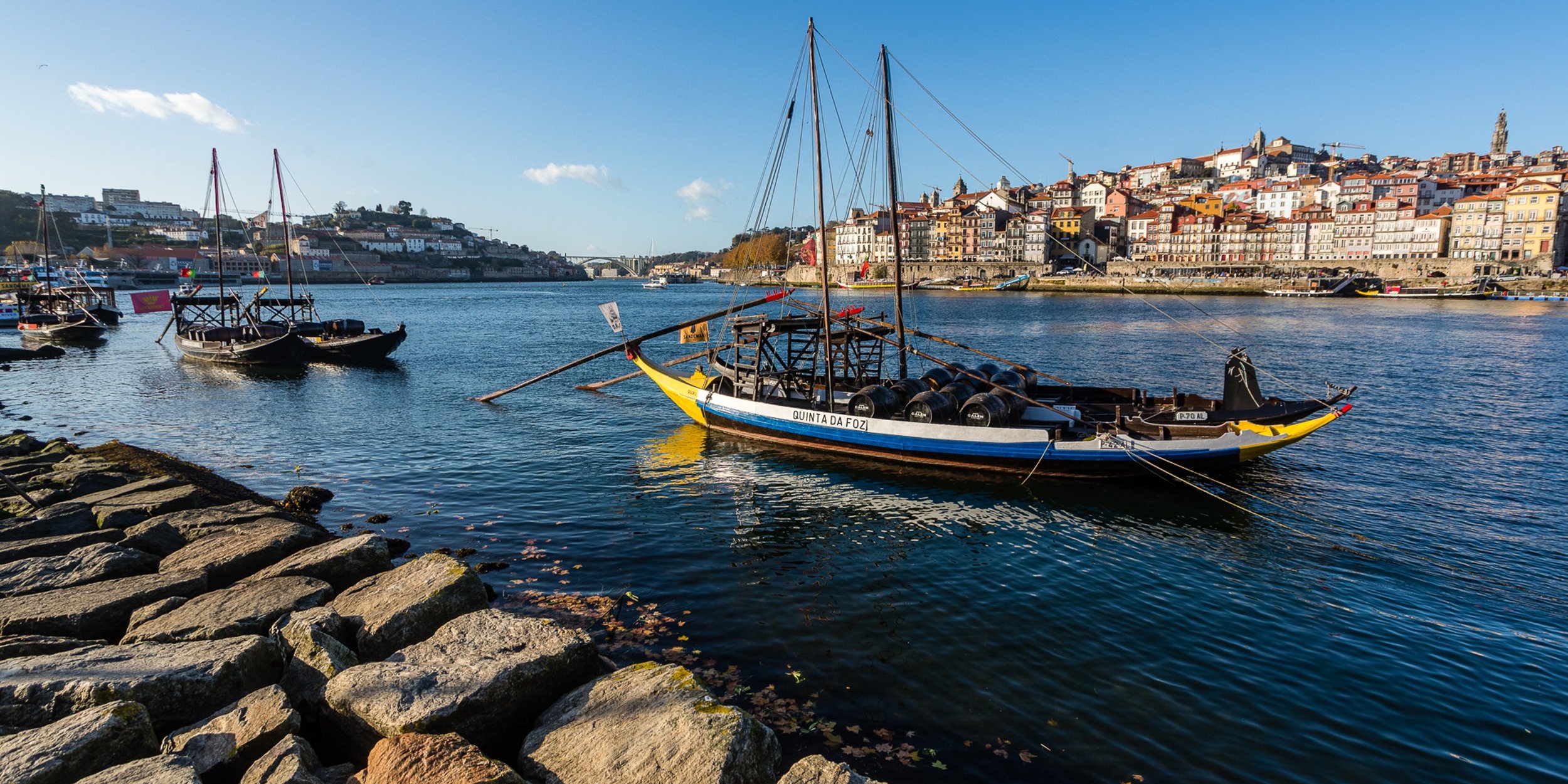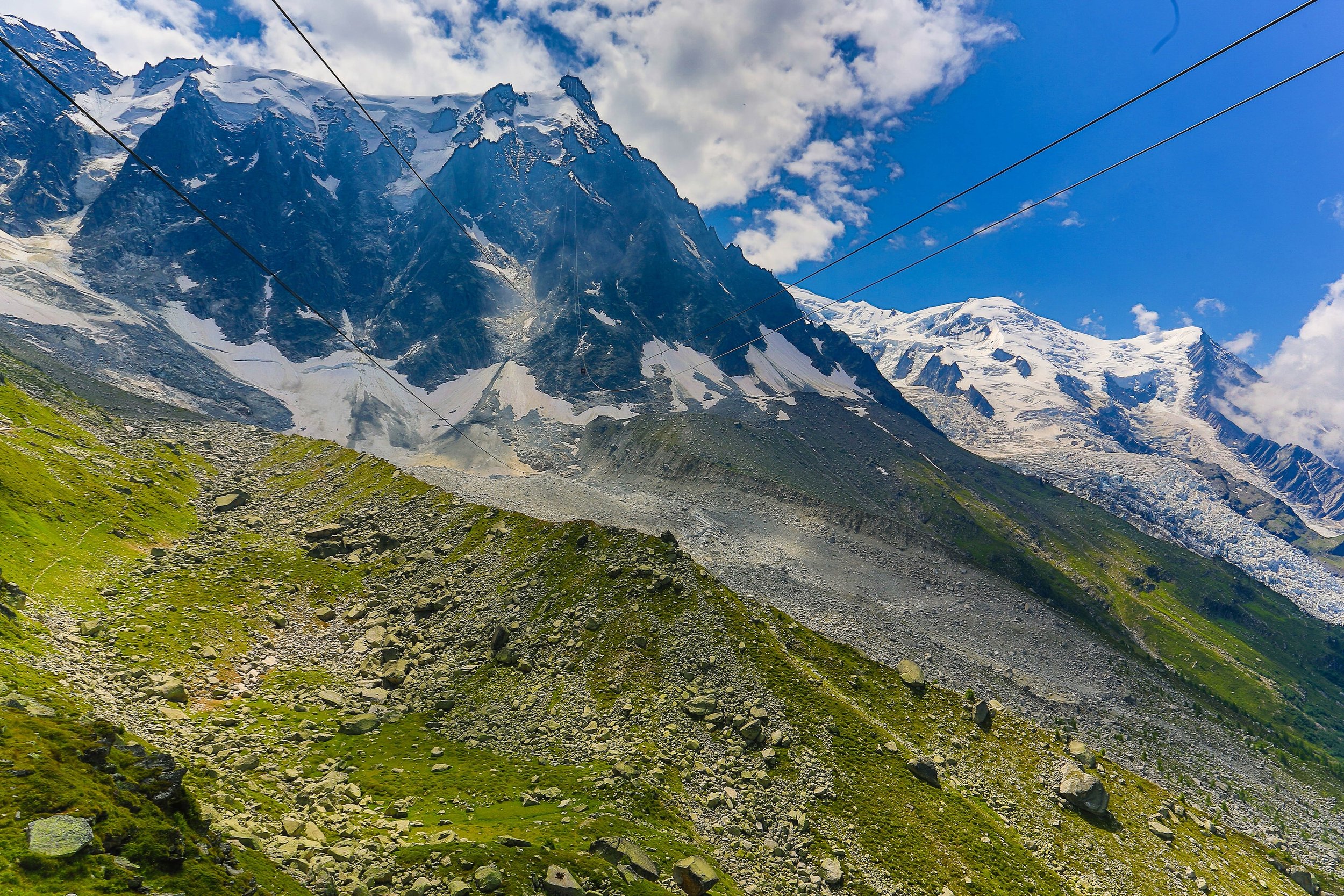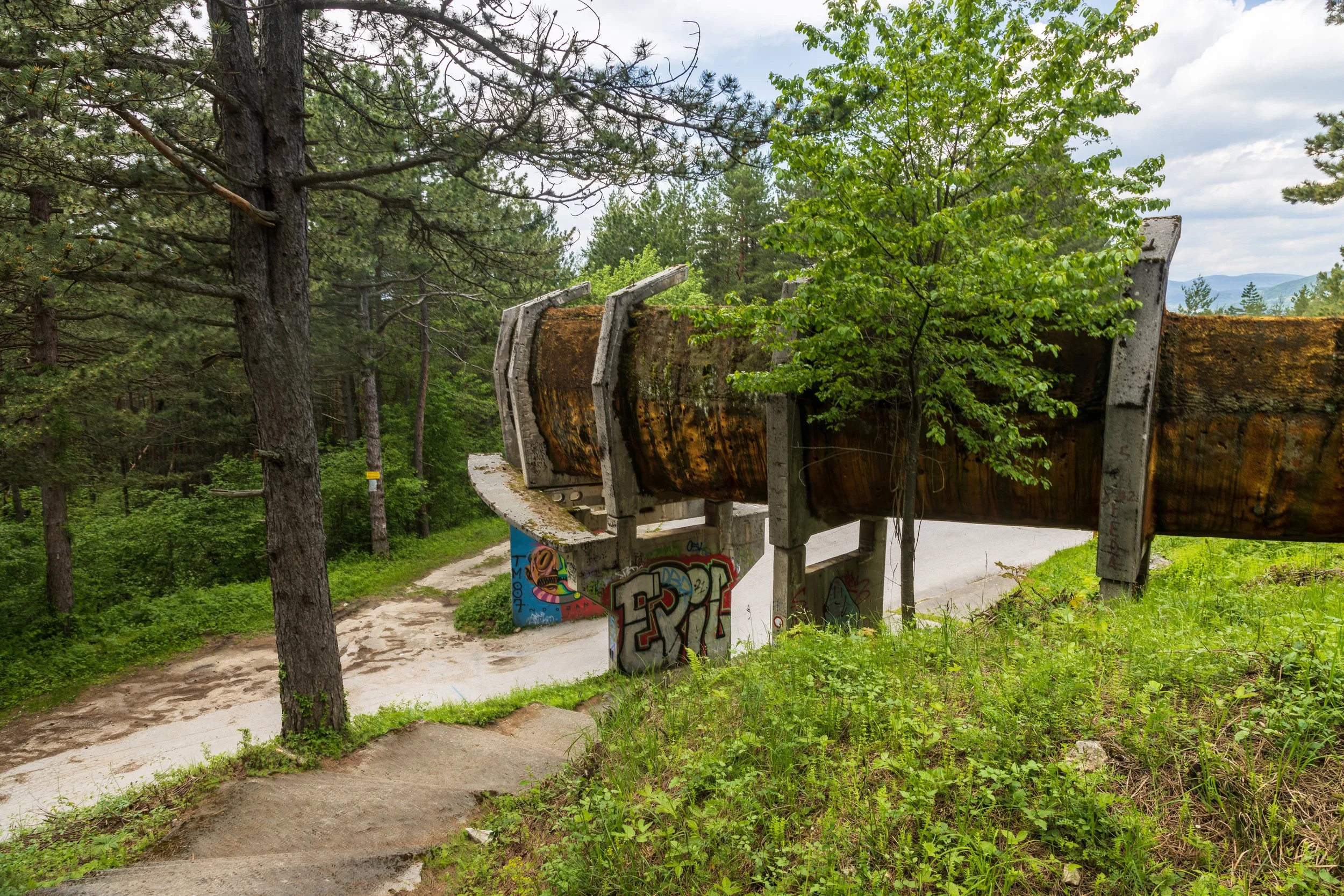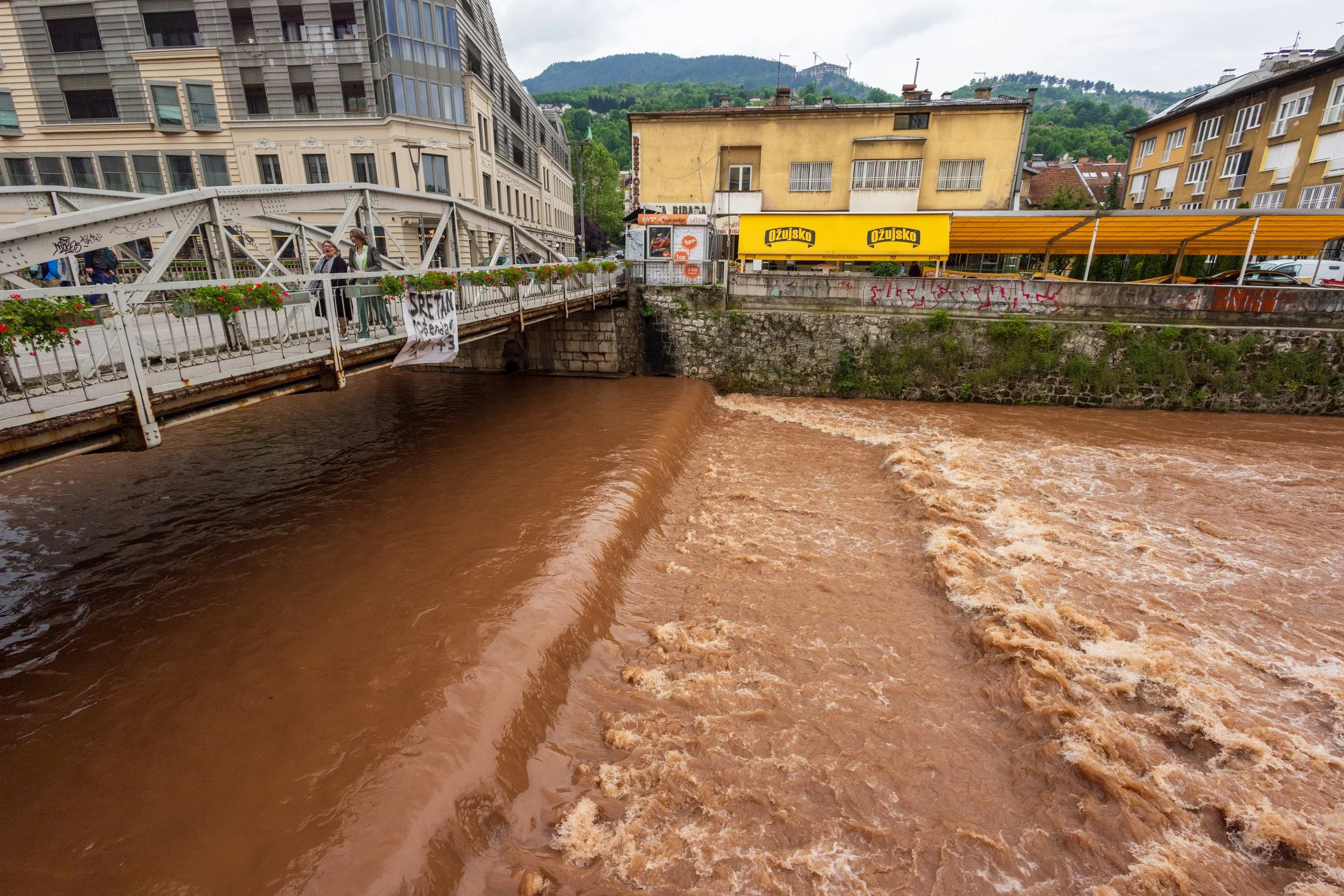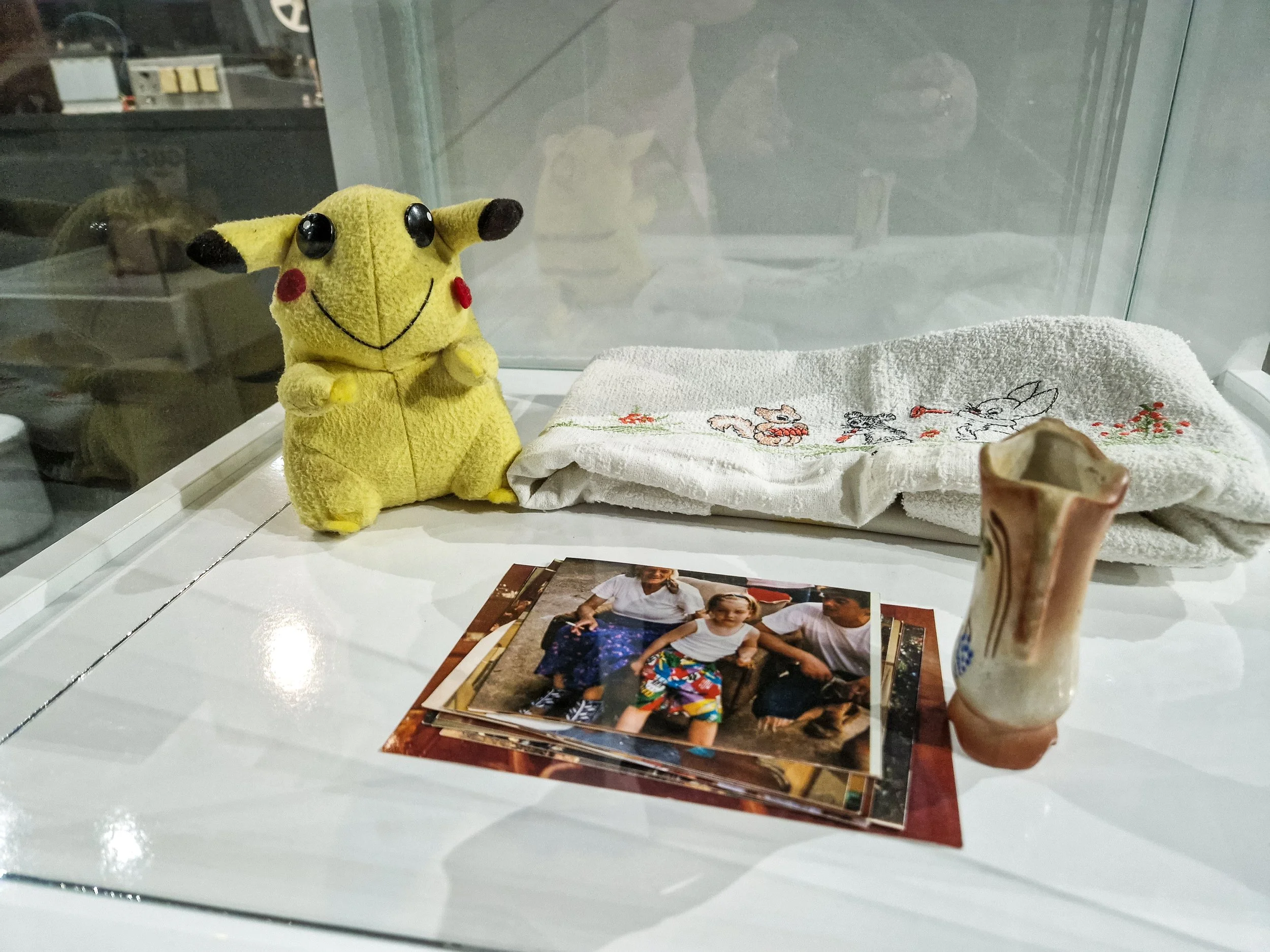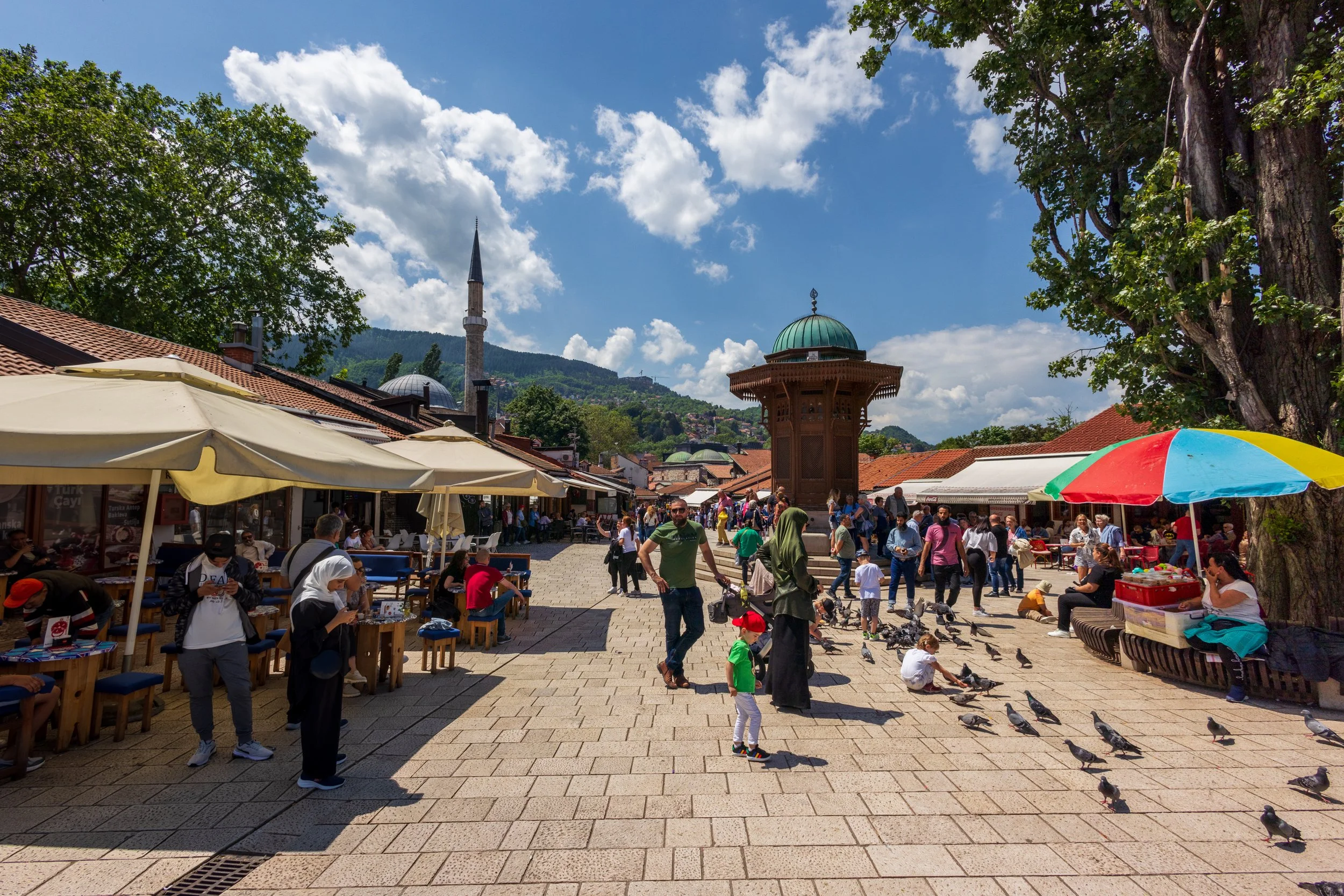Sarajevo
Sarajevo is a fulcrum of history, twice in the past century events in this city have shaped the world, and both times it has been tragedy and darkness. Once in 1914, the Great War started with the assassination of Archduke Franz Ferdinand, and then in 1992, with the violent, gradual collapse of Yugoslavia, Bosnia and Herzegovina went through a civil war and a genocide.
As a city, the scars remain, but it has a bustle and sense of life. The city is clean, for a capital city, and whilst there is a lot of graffiti, it is broadly ‘good’ graffiti. There are clear indications in the architecture and attitudes that this is a predominantly Muslim city, and if you missed the clues, the regular calls to prayer will remind you, but perhaps because of the recent conflicts, it is an open-minded city in many ways.
I was in Sarajevo for 3 days, two days exploring the city and a day on a tour of Herzegovina.
Sights & Culture
Bijela tabija (White Fortress)
Little really remains of the White Fortress, in truth, you'll find yourself immersed in a landscape where nature has reclaimed its dominion. The once mighty walls, now half their original size, stand as a testament to the passage of time, their stones weathered and worn and often graffitied. The roof, long since disappeared, has given way to the open sky.
As you navigate through the overgrown grass and weeds, you'll find yourself in a place where history and nature intertwine. The fortress, despite its dilapidated state, still commands an impressive view of Sarajevo. From this vantage point, you can appreciate the city's layout, its rooftops forming a mosaic of colours and shapes against the backdrop of the surrounding hills.
The White Fortress is more than just a historic site; it's a place of reflection, a place to ponder the passage of time and the transient nature of human endeavours. It's a place that reminds us of the enduring power of nature and the resilience of the human spirit. Despite its current state, the fortress continues to stand, a silent guardian watching over Sarajevo, its walls echoing with the stories of the past.
Žuta Tabija (Yellow Fortress)
The Yellow Fortress, or Žuta Tabija, is a charming contrast to its larger counterpart, the White Fortress. Perched halfway up the same hill, it's more of a solitary tower than a sprawling fortress, yet it holds its own unique appeal. Here, you're not just a spectator but an active participant in history. You're free to scale the remaining walls, feeling the rough texture of the stones under your hands and the thrill of height as you look down at the road on one side and the cosy café tables on the other.
This isn't a place that's been overly sanitised or commercialised. You'll often find locals strolling around, their voices filling the air with stories of the past. For a small donation, they'll share their historical insights, adding depth and context to your visit.
Sahat-kula (Clock Tower)
The Sahat-kula, or Clock Tower, is an intriguing feature nestled in the heart of a bustling block of buildings in Sarajevo. It's not as towering as you might expect, especially when compared to the lofty minarets of the nearby mosques. Yet, its modest height doesn't diminish its significance or its charm.
What makes the Clock Tower truly fascinating to me is the hidden room tucked away inside. During the day, it's a secret kept by the tower's sturdy walls. But as night falls, the room suddenly becomes visible, its presence illuminated for all to see.
Višegradska kapija (Višegrad Gate)
The Višegrad Gate, a squat stone tower, stands at a Y junction of the main road in Sarajevo. It's a silent sentinel, a reminder of the city's past when it would have been part of a larger defensive wall encircling the city. Now, it watches over the road that splits, one way continuing up the hill, the other veering right towards the White Fortress. It's a modest structure, especially when compared to the grandeur of the city's mosques or the imposing White Fortress. Yet, there's something about its unassuming presence that makes it a compelling stop on any exploration of Sarajevo. It's as if the stone itself holds stories of the city's past, waiting for those who take the time to listen.
Vječna vatra (Sarajevo Eternal Flame)
The Sarajevo Eternal Flame, or Vječna vatra, is a symbol of the city's resilience. Located at the intersection of three roads in the Old Town, this memorial is dedicated to the military and civilian victims of the Second World War. It was unveiled on April 6, 1946, marking the first anniversary of Sarajevo's liberation from Nazi Germany and the fascist Independent State of Croatia. The flame burns brightly day and night, a beacon of remembrance that draws both locals and tourists. It's not uncommon to see couples posing for photos here, perhaps drawn to the symbol of enduring love that an eternal flame represents. But the flame also serves as a stark reminder of the city's turbulent past, a testament to the resilience of its people.
Narodno pozorište Sarajevo (Sarajevo National Theatre)
The Sarajevo National Theatre, located in the heart of the city, is an architectural gem that has been a cultural hub since its establishment in November 1921. The theatre was designed by Karel Pařík, a renowned architect responsible for over 160 other buildings in Sarajevo. The theatre is a testament to the city's vibrant arts scene, hosting a variety of performances, from opera to ballet. During my visit, the theatre was buzzing with activity, with elegantly dressed students thronging the entrance, adding to the lively atmosphere. The theatre's grandeur and the energy of the crowd left a lasting impression, making it a memorable part of my visit to Sarajevo.
Musical stairs
The Musical Stairs in Sarajevo, once a charming spot, have lost some of their allure due to the passage of time and the impact of graffiti. Scattered along the staircase are metal 'music boxes', accompanied by metal seats and tables, a unique concept that should make this place more appealing than it currently is. The stairs border a park, adding to the potential charm of the location. However, the reality falls short of the potential. It's a place that echoes with the melody of what it once was, and what it could be again with a bit of care and attention.
Avaz Twist Tower
The Avaz Twist Tower, a modern marvel in Sarajevo, stands somewhat alone, set back from the main road and closer to the train station. Its sleek design and towering height make it a standout feature in the city's skyline.
ICAR Canned Beef Monument
A peculiar yet compelling sight, the ICAR Canned Beef Monument gives off Warhol vibes. It's a nod to the city's past, as canned beef was a main item in relief packages during the war. Its significance to many Bosniaks is undeniable.
Sebilj
At the heart of one of the main touristy plazas, you'll find Sebilj, a charming wooden fountain. It's a popular spot for both people and pigeons, and you can enjoy a good look at it from one of the many surrounding cafes.
Monument to the multiethnic human
Located in a park facing away from the Church, the Monument to the multiethnic human is a simple but elegant plea on the universality of man. It's a quiet reminder of the city's diverse population and shared humanity.
The Equilibrists Over River
Between two bridges, you'll find metal acrobats trying to cross the fast-moving river. It's a playful and unexpected sight that adds a touch of whimsy to the cityscape.
Hotel Holiday
The bright yellow Hotel Holiday is a symbol for many in Sarajevo of the Winter Olympics of 1984. Opened for the games, its bright colour was a significant departure from most other buildings in the area, making it a standout feature.
The Academy of Fine Arts
The Academy of Fine Arts in Sarajevo is a testament to the city's commitment to the arts. It offers a multitude of courses across six departments, and its building, a former church built in 1899, is a cultural-historical monument. The academy introduced the Bologna educational system in the 2006/07 school year, further cementing its place as a leading institution for arts education.
Churches
Sacred Heart Cathedral
The Sacred Heart Cathedral is a large Christian church painted in pastel yellow. Located in the centre of town, it's hard to miss. A huge silver statue of Pope John Paul II stands outside, adding to its grandeur.
Cathedral Church of the Nativity of the Theotokos
Closer to The Sacred Heart than you’d expect, this second large Christian church faces a small park. Its proximity to another major religious site is a testament to Sarajevo's religious diversity.
Mosques
Baščaršija Mosque
This large mosque is tucked away behind walls near the central plaza. It's a significant place of worship in the city and a testament to Sarajevo's rich Islamic heritage.
Gazi Husrev-beg Mosque
This national monument is one of the largest mosques in Sarajevo. Tours are available for those interested in learning more about its history and significance.
Tašlihan
The ruins of Tašlihan are located in the centre of town. A café from Hotel Europa spills out over them, providing a nice spot to soak in the history.
Broken Bobsled Run
About fifteen minutes from the top of the cable car is the Bobsled run from the Winter Olympics. Some sections have collapsed, while others remain. Graffiti covers much of it, and nature is slowly reclaiming the area.
Bistrik Tower
About half an hour’s hike downhill, along the bobsled track, you can take an unmarked trail off into the forest a short distance and see the ruins from the 1960s of the observatory. It's worth a look if you're already following the bobsled.
Bridges
The river through Sarajevo is crossed by a lot of bridges. Mostly small footbridges some area larger and can be driven across. One is infamous.
Latinska Ćuprija (Latin Bridge)
Also known locally as the Assassination Bridge, this ancient stone bridge was the spot where Archduke Franz Ferdinand was assassinated, leading to the start of the Great War.
Museums & Galleries
There are a lot of museums in Sarajevo, and you can easily spend a great deal of money on tickets to get in. The cheapest I found was the Jewish Musuem at 3 Marke and that was easily the best value, most are 10.
War Childhood Museum
The War Childhood Museum in Sarajevo is a unique institution, the only one of its kind in the world dedicated to exploring the impact of war on childhood. The museum was born out of a crowd-sourced book titled 'War Childhood' and has since grown into an international platform that gives voice to current and former war children. The museum's collection is composed of personal stories and objects, providing a deeply personal and emotional exploration of war's impact on children. The museum has been recognized for its significant contribution to understanding and healing, receiving the 2018 Council of Europe Museum Prize.
The museum is not just a place of passive observation, but an active platform for tackling trauma at an individual level. It provides a space for both participants, whose personal stories and objects comprise the museum’s collection, and visitors to confront the traumas of war. The museum's impact extends beyond its physical location, with projects in Bosnia and Herzegovina, Serbia, Lebanon, Ukraine, and the United States.
The War Childhood Museum is a must-visit in Sarajevo, not just for its historical significance, but for its ongoing mission to foster understanding and healing. It's a place that leaves no visitor unchanged, a testament to the resilience of children and the enduring human spirit.
Sarajevo Museum 1878 – 1918
The Sarajevo Museum 1878 – 1918, on the other hand, is a smaller, single-room museum that might not be worth the time unless you're a particular scholar of the assassination of Archduke Franz Ferdinand.
Siege of Sarajevo Museum
The Siege of Sarajevo Museum is a small institution near the Genocide museum. It focuses more on the suffering of the people during the siege, with a small collection of personal items and stories. The museum by the Cable Car, run by a family who survived the siege of Sarajevo, provides a more personal and raw exploration of the horrors of the siege.
Museum of Crimes Against Humanity and Genocide
Absolutely worth visiting, and spending time there, but it is not an enjoyable experience. In some ways, it hits harder than Holocaust museums I have visited as despite the scale of the genocide not being close to the Holocaust the proximity in time is unsettling. We like to tell ourselves comforting lies. The people of the distant past, those living and making decisions in the 1930s and 1940s were very different from us, they lacked our modern sensibilities and so, something like that would never happen to ‘us’. Sarajevo puts the lie to that claim. 10 short years after hosting the Winter Olympics, Sarajevo became a battleground and the site of genocide.
Stories and mementoes make up this museum, it’s less about the broad strokes of history and more about the personal ones. Read about the son of Bosnia’s champion bodybuilder who Schwarzenegger reached out to after hearing of his father’s execution. Of the doctor who saved so many lives in a concentration camp using whatever he could find, thread from potato sacks, his own teeth, and whose patients applauded him as he was taken off from the camp to his death as there was nothing else they could do. Read about the four-week-old baby shot to death with her family, holding her bottle.
No, it’s not a comfortable experience, but it is a necessary one.
Gallery 11/07/95
Above a dentist, you take a small cramped elevator up to a modern gallery. Pay the extra five Marke for an audio guide, it is worth it. The first room is lined with portrait photographs of a handful of the victims of the genocide. The main room has photographs from the founder of the museum, a visual documentary of the immediate aftermath. A broken doll. Rows upon rows of bags of clothes. Two men from the United Nations standing beside a mass grave. A single drop of blood, the way the victims were identified, through unpreceded DNA analysis.
Olympic Museum
In 1984, beating Gothenburg and Chamonix for the honour, Sarajevo hosted the Winter Olympics. As a Brit, I know the year well due to our star competitors, Torville and Dean. As a Swede, I’m still a little salty Gothenburg didn’t get the chance to host.
The museum is colourful, shiny and bright, its a good antidote to many of the museums you’ll spend time in Sarajevo.
Information on the event, the decisions made, how the artwork was chosen and how much construction was done paints an interesting picture of the flurry of activity that must have brought the city together.
National Gallery of Bosnia and Herzegovina
The National Gallery of Bosnia and Herzegovina, founded in 1946, is a key cultural institution in Sarajevo. Its collection, which initially comprised 600 pieces from the National Museum of BiH, has grown to over 6,000 works. These are divided into several collections, including the BiH Art Collection, the Ferdinand Hodler Collection, the Icon Collection, the Yugoslav Art Collection, the International Donations Collection, the Photography and New Media Collection, and the "NADA" ("HOPE") Art Archive.
During my visit, I was greeted by a curator who spoke French to me, adding a personal touch to the experience. The exhibits were varied, with one focused on horses, which was small but interesting. Another exhibit that caught my eye was one filled with vibrant colours. The permanent collection was particularly intriguing, with a quote about 'impressionism' that stuck with me.
The gallery is housed in a building designed by Josip Vancaš in 1912 and was originally used as a department store owned by Jewish merchants, Ješua and Mojca Salom. Despite the tumultuous times during the war from 1992 to 1995, the gallery remained operational, hosting 42 exhibitions.
Whether you're an art enthusiast or a casual visitor, the National Gallery of Bosnia and Herzegovina offers a rich and diverse cultural experience that is worth the visit.
The National Museum of Bosnia and Herzegovina
The National Museum of Bosnia and Herzegovina, located in the heart of Sarajevo, is a treasure trove of cultural and scientific artifacts that span the breadth of human history in the region. Established in 1888, the museum houses four pavilions dedicated to archaeology, ethnology, natural history, and a library.
The Bronze Age exhibits are particularly noteworthy, offering a glimpse into the rich and complex history of human civilization in Bosnia and Herzegovina. The museum's Paleolithic section is equally fascinating, providing insights into the earliest known human activities in the region.
The Natural History Museum within the National Museum is a must-visit for nature enthusiasts. It showcases the diverse flora, fauna, and geology of Bosnia and Herzegovina. The Botanical Garden, though small, is a charming space that adds a touch of green to the museum complex.
The museum's library is a haven for book lovers and researchers, housing an impressive collection of around 162,000 volumes. It's a testament to the intellectual and cultural heritage of Bosnia and Herzegovina.
Despite the challenges faced during the Bosnian War and subsequent funding issues, the National Museum of Bosnia and Herzegovina stands as a symbol of the country's resilience and commitment to preserving its rich history and culture. It's a must-visit for anyone seeking to understand the country's past and present.
History Museum of Bosnia and Herzegovina
The museum, which houses over 400,000 historical artifacts, was established in 1945 and was once known as the Museum of the Revolution of Bosnia and Herzegovina. The museum is divided into two main sections. The upper floor is dedicated to the political history of Bosnia and Herzegovina's separation, featuring a collection of portraits and historical documents that tell the story of this tumultuous period. It's a sobering reminder of the country's past, but also a testament to its resilience.
The lower floor, on the other hand, offers a unique sensory experience with the Sound Link exhibit. This noise-focused art exhibit is a fascinating exploration of sound and its impact on our perception of the world. It's a different way to experience history, one that engages not just your eyes, but your ears as well.
Despite its small size, the History Museum of Bosnia and Herzegovina is a must-visit for anyone interested in understanding the country's past and how it has shaped its present.
Sarajevo City Hall & Ars Aevi
The Sarajevo City Hall, also known as Vijećnica, is an impressive structure located near the infamous Latin Bridge. Designed in 1891 by Czech architect Karel Pařík, it was the largest and most representative building of the Austro-Hungarian period in Sarajevo, serving as the city hall. The building was reopened in 2014 and now serves as the seat and headquarters of the Mayor of Sarajevo, as well as the Sarajevo City Council.
The City Hall is divided into three sections. The first is a small museum focused on the genocide, complete with a replica of the courtroom from the International court. It provides information on all the guilty parties and features a chilling real wall from a theatre where actors were shot. The second section is a two-floor art gallery called Ars Aevi, which displays haunting pieces reflecting on the horrors of the genocide. Lastly, there is a small dedication to Archduke Franz Ferdinand and his wife.
The building itself is a sight to behold, with its pseudo-Moorish architecture and intricate designs. However, the real value lies in the stories and history it holds within its walls. It's a place that reminds you of Sarajevo's past, but also of its resilience and its journey towards the future.
Ars Aevi
War Museum 1992
Run by a family who survived the siege of Sarajevo, this museum has an edge to it that most others lack. Organised for the science of history and education, museums aim for a level of dispassion that this museum does not even try for.
Handwritten signs are scatted through the crowded rooms. A sub-room as example of Bosnia’s own Anne Frank, a girl who turned 18 during the siege, writing in her diary of the experience. The tickets are automated and the museum is unmanned, which is also slightly unnerving.
One fascination section shows the comparative value of items used for trade, and how bizarrely things like coffee and cigarettes, luxury consumables formed much of the basis for the black economy, and that gold lost its value. A surprise perhaps for our doomsday preppers stockpiling precious metals for their post-apocalyptic fantasies.
Museum of the Jews of Bosnia and Herzegovina
Tucked away in the heart of Sarajevo, the Museum of the Jews of Bosnia and Herzegovina offers a deeply personal and intimate exploration of Jewish history in the region. Spread across three floors, the museum is small but brimming with stories and artefacts that paint a vivid picture of Jewish life in Bosnia and Herzegovina.
On display, you'll find a range of artefacts, including an example of a Jewish wedding certificate, a testament to the community's rich traditions and customs.
The top floor is dedicated to the Holocaust, a sombre reminder of the atrocities faced by the Jewish community during World War II. Despite its small size, the museum leaves a lasting impression, offering a poignant and moving tribute to the Jewish community's resilience and enduring spirit. It's a must-visit for anyone seeking to delve deeper into the diverse tapestry of cultures that make up Sarajevo's history.
Parks & Gardens
Parks and Gardens are scattered through Sarajevo, none very large and many serving a grim double purpose of garden and cemetery. (Though the same can be said for London)
Viewpoint of Sarajevo
This is an excellent spot to get a bird's eye view of the city. It's a popular place for tourists and locals alike to enjoy the picturesque landscape of Sarajevo.
Veliki park
This is one of the largest and most beautiful parks in Sarajevo. It's a perfect place for relaxation, picnics, and leisurely walks. The park also hosts various events throughout the year.
Mali park
This small park is a charming green space in the heart of the city. It's a great place to take a break from the hustle and bustle of city life.
Gondola lift station
While not a park, this is a must-visit for its awesome gondola ride. The ride offers stunning views of the city and the surrounding mountains, as well as the chance to do some hiking.
Park by Church with multi-ethnic humans
A small, central park with a number of statues and artworks, like the Monument to the multiethnic human, it faces one of the larger Churches in Sarajevo. The park is popularly used by older men playing with the large chessboard.
Restaurants & Bars
Coffee and cake are important to the people of Sarajevo, and Bosnian coffee in particular is worth taking the time to enjoy. Dark, thick bitter coffee, served in a copper jug, you pour it into small cups yourself, dunk a sugar cube into the inky black coffee and let some of it dissolve on your tongue. Then a sip of coffee, the sugar balancing the bitterness, and then a mouthful of water to cleanse the pallet. It’s as much ritual as it is beverage and it addresses one of my biggest frustrations with espresso, namely the fact it is gone in moments.
Caribou Coffee
Imitating international chains like Starbucks, Caribou is a fairly common sight through Sarajevo with a younger-skewing client base to the myriad of more traditional cafes offering Bosnian Coffee.
Dveri
An excellent, small restaurant near Baščaršija. The interior is full of plants and the menu is excellent.
Sedef
Tucked away in the central courtyard of a block of buildings Sedef feels more authentically local and many of the more visible restaurants. I had the local speciality of a Bosnian Stew which was hearty and filling, especially with the fresh bread.
Metropolis Tea & Coffee
A basic chain coffee place in the SCC.
Restoran Gravur
I stopped here, to enjoy the sunlight and have a Bosnian Coffee. Its location lets you enjoy people-watching people milling around Baščaršija.
Aeroplan
With a lovely outdoor courtyard space, I tried the delicious ćevapi for the first time.
Saraj Slasticarna
Nice little cafe on the main square by the fountain, the staff are abrupt, something that seems to be their ‘thing’ based on their reviews, but the coffee was good and the baklava was excellent.
Klopa
Outstanding food, a really lovely medium rare steak from a local farm with fresh vegetables. Dessert was a fruit cake in custard. The staff were very helpful and attentive.
Aščinica Dženita
A small cafe, with a friendly owner who joked I owed him 200 EUR for my ćevapi lunch.
Kamarija
On the way to the two fortresses, a nice little cafe with a fantastic view.
Shoppping
Baščaršija
Baščaršija is the historical and cultural heart of Sarajevo, a vibrant old bazaar that dates back to the 15th century. This bustling market area is a major tourist attraction, brimming with shops selling similar items, making it a perfect spot for souvenir hunting. The area is also known for its outdoor cafes and a charming central plaza, offering a delightful spot to sit, sip a Bosnian coffee, and watch the world go by.
Sarači
Sarači Street is another tourist hotspot in Sarajevo. It's a lively street that connects to Baščaršija, offering a variety of shops and eateries. The street is always buzzing with activity, making it a great place to soak in the local atmosphere and pick up some unique finds.
Latin Market
The Latin Market is reminiscent of a Turkish bazaar, with a plethora of jewellery stores. It's a great place to browse for unique pieces and haggle with the vendors for a good deal. The market's vibrant atmosphere and array of goods make it a must-visit for shoppers.
Ferhadija
Ferhadija is the main tourist street in Sarajevo that connects to Sarači. It's a bustling area with a variety of shops and eateries, making it a great place for a leisurely stroll. The street is always buzzing with activity, offering a lively atmosphere for shopping and dining.
SCC
The Sarajevo City Centre is a modern three-story shopping mall located in the new town, close to the National Museums. The mall is primarily focused on clothing and perfume items, offering a variety of brands for shoppers to choose from. Its modern architecture and wide range of stores make it a popular shopping destination.
Pijaca Markale food market
The Pijaca Markale Food Market is a vibrant spot where locals and tourists alike can find a wide variety of fresh produce, local delicacies, and other food items. It's a great place to experience the local food culture and pick up some delicious treats.
Sports & Activities
There are a lot of tours and opportunities from Sarajevo, many heading to Mostar for its history and its reputation as a tourist capital.
Mostar and Herzegovina 4 Cities
A few companies organise tours broadly similar to this, stopping at Jablanica, Konjic, Studenci and finally, Mostar to see the old town and the city. Read about my experiences here:


